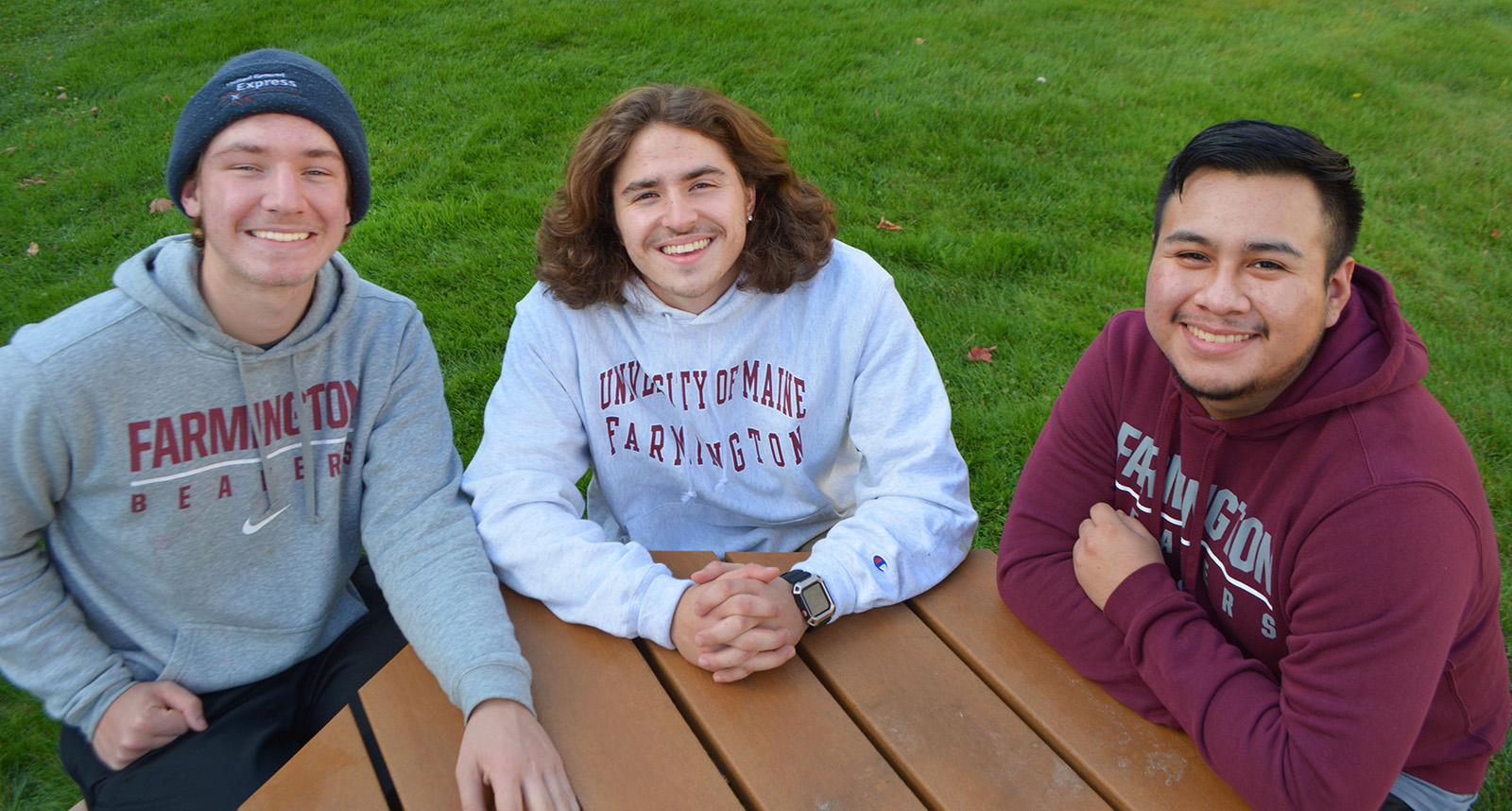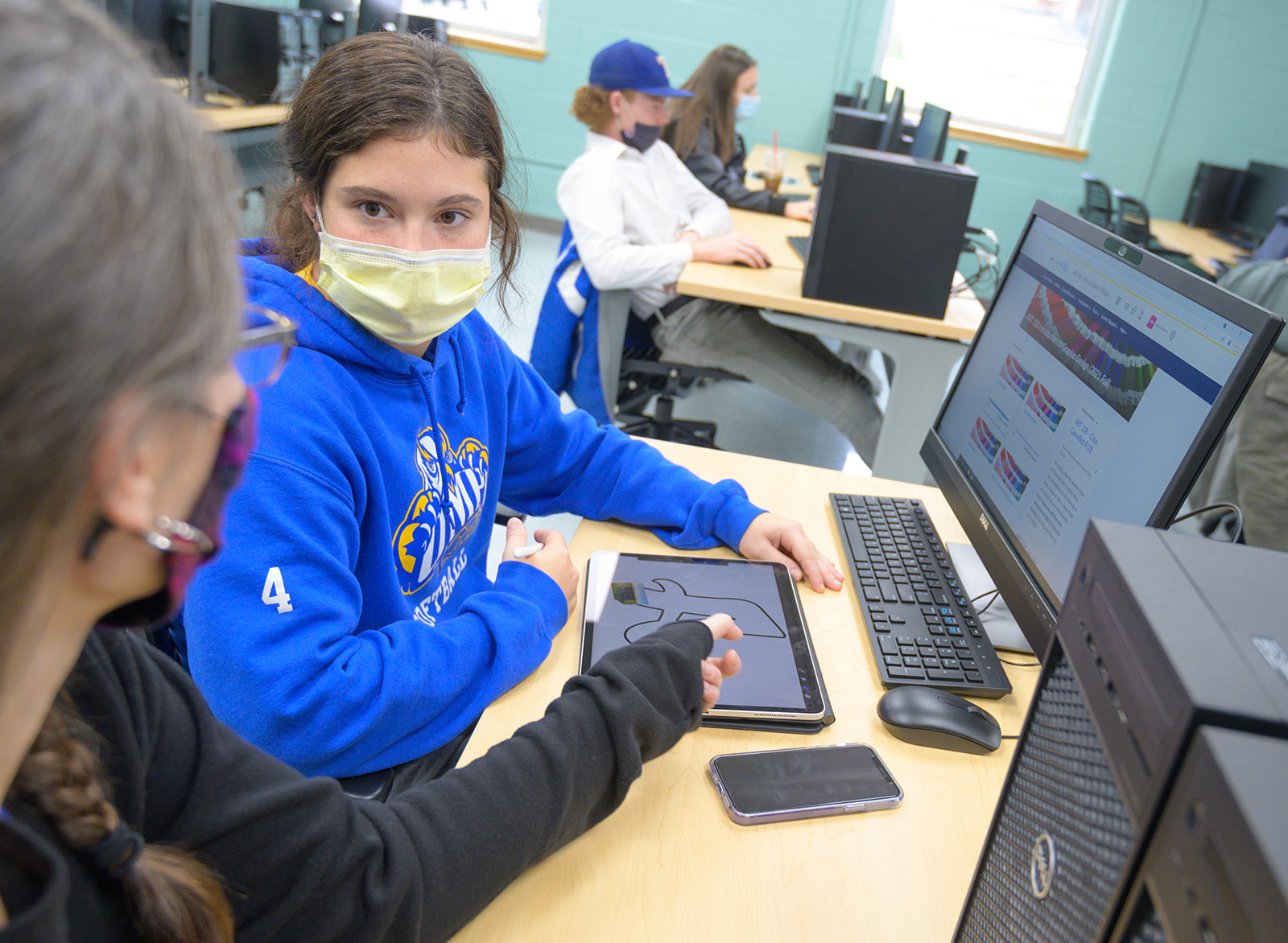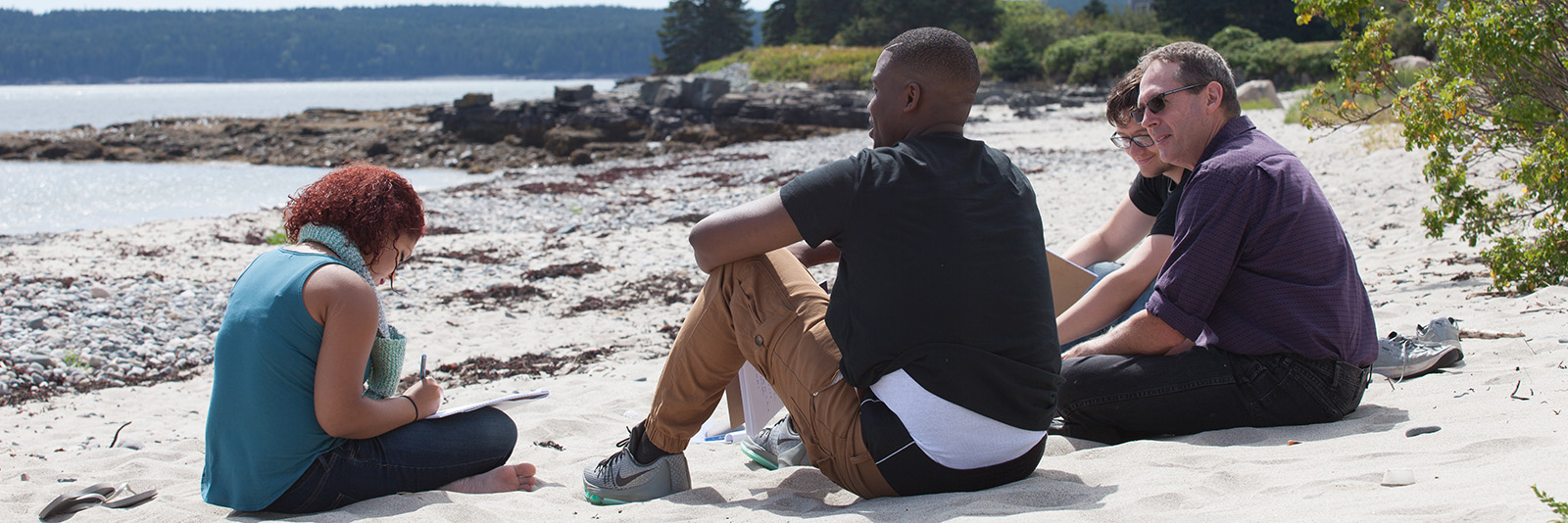Upon granting unified accreditation to the University of Maine System in July 2020, our regional accreditor, the New England Commission of Higher Education (NECHE), asked us to prepare a self-study in advance of a Fall 2022 visit by a NECHE-appointed evaluation team. Standard Four: The Academic Program can be found on this page.
Description
Students at University of Maine System (UMS) universities may select from 239 undergraduate majors, 399 minors, 361 concentrations, and 25 associate degree programs. All majors in UMS introduce students to subject matter that is broad and substantive with respect to theory, content, and methods of inquiry and analysis. Students progressing through the major develop in-depth knowledge and mastery of at least one disciplinary or interdisciplinary area. Some degree programs require a minor while others require a concentration.

| Level | Fall Term | In-State | Out-of-State |
|---|---|---|---|
| Undergraduate | 2012 | 20,630 | 3,070 |
| 2013 | 19,999 | 3,310 | |
| 2014 | 19,101 | 3,605 | |
| 2015 | 18,296 | 3,869 | |
| 2016 | 17,536 | 4,259 | |
| 2017 | 16,657 | 4,754 | |
| 2018 | 16,290 | 5,022 | |
| 2019 | 15,879 | 5,122 | |
| 2020 | 15,062 | 5,577 | |
| 2021 | 14,155 | 5,940 | |
| Graduate/Law | 2012 | 2,690 | 682 |
| 2013 | 2,471 | 663 | |
| 2014 | 2,459 | 650 | |
| 2015 | 2,321 | 691 | |
| 2016 | 2,410 | 721 | |
| 2017 | 2,461 | 740 | |
| 2018 | 2,585 | 789 | |
| 2019 | 2,673 | 861 | |
| 2020 | 2,885 | 1,182 | |
| 2021 | 3,015 | 1,481 |
Assuring academic quality
UMS offers courses and programs at its universities and Law School and at instructional centers statewide. This footprint reflects Maine’s physical size and UMS’s commitment to meeting the needs of a student body that is especially diverse in its access to technology, levels of degree and certificate attainment, and socio-economic means.
Each university maintains a portfolio of academic degree offerings and a system of academic approval and oversight. This system is initiated by university faculty, who control course content and program requirements. When program suspension or elimination prevents students from progressing and completing a program in the publicized amount of time, the university arranges for alternative coursework or a teach-out plan.
Program review cycles are followed at each university, and UMS policy guides program development, approval, administration, and review. Faculty have a substantive voice in these processes. Student success and program effectiveness are measured in various ways, including evidence of meeting learning outcomes and student feedback. National recognition of several programs demonstrates an external perspective on student success and program effectiveness. Each university maintains procedures for proposing new or revised programs. Such changes are typically initiated by faculty. Proposals include a rationale addressing potential effects on students, faculty, and extant resources. Proposals advance through university levels of faculty governance and administrative oversight, with consideration at the UMS level by the Vice Chancellor for Academic Affairs (VCAA), Chief Academic Officers Council (CAOC), and Board of Trustees (Board). Through this process, UMS and its universities assure programmatic capacity and sustainability as well as alignment with NECHE standards.
When programs are eliminated, the universities continue to offer required courses or appropriate substitutions so students can progress to completion. Examples include the opportunity for UMFK students to continue their coursework through UMPI when UMFK suspended its education program, and UMF’s adding of course sections to accommodate the needs of students in the precursor of a recently revised elementary education program.
At all UMS universities, program requirements are published in a variety of ways to ensure student achievement expectations are clear. Through academic and program assessment, faculty assure that student learning, information literacy, skills in inquiry, and critical judgment are connected and are appropriate to subject matter and degree level.
Undergraduate degree programs
While there is some flexibility, UMS majors require undergraduates to start with and complete foundational and supportive coursework (100- and 200-level courses) before progressing to more advanced coursework (300- and 400-level courses). Courses are sequenced so learning and expertise build throughout the academic program and culminate in a required capstone course, generally taken in a student’s senior year. Suggested and required course progressions are delineated in the universities’ undergraduate catalogs and are easily accessed by students from the universities’ websites.
Program overviews and degree requirements for individual majors are available in the undergraduate catalogs. In many cases, this information is further available to students on college and/or departmental websites and from faculty advisors or professional advising staff. Student learning goals for academic programs are published on departmental and/or college websites.
All undergraduate degree programs include general education, major, minor, and concentration requirements that are clearly articulated in catalogues and websites. Advanced courses identify prerequisites to enrollment that may include introductory courses, a GPA threshold, required benchmarks, and/or instructor permission.
UMS students can select from a number of 3+3 and 4+1 programs in various fields. The Law School, for example, has established 3+3 partnerships with six of the seven UMS universities enabling qualified students to obtain a bachelor’s and a J.D. in six years. Since 2018, the Law School has enrolled 10 USM students through the 3+3 partnership, and in fall 2022 matriculated its first 3+3 student from UM. It is expected that advising students about the 3+3 option in the early years of their undergraduate program will yield additional students through this pathway.
As discussed in detail in Standard Eight, program assessment at UMS universities relies on formative and summative assessment measures and the application of findings to the continuous improvement of student learning. For example, as noted in the university’s E Series data, UMFK’s Rural Public Safety Administration program uses outcomes from a capstone course, an internship evaluation by the employer, and a student portfolio to improve student learning and strengthen course and program outcomes.
Students completing undergraduate or graduate programs demonstrate collegiate-level skills in the English language.
General education
Each university has a well-developed general education program and assessments that meet NECHE standards. Learning outcomes are established both broadly and for each course requirement and are assessed using indirect assessment mechanisms, including but not limited to: tracking studies completed by assessment offices, review of core courses at the assignment and syllabus level to ensure attention to the outcomes, analyzing student responses on NESSE items related to the goals of general education, focus groups with students, and course-level surveys.
For example, assessment data from the University of Southern Maine (USM) exit surveys reveal a high level of student confidence in critical thinking skills, analysis of quantitative problems, and effective independent learning.
General education requirements in each UMS undergraduate program ensures adequate breadth for all degree-seeking students. General education outcomes are defined for each baccalaureate and associate’s degree to include courses in the arts and sciences, humanities, mathematics, and social sciences.
The number of required credits, general education outcomes, list of courses that satisfy general education requirements, and performance expectations are housed in university catalogs and on university websites. Student academic plans define the courses that meet general education outcomes and the total credit requirements for baccalaureate and associate degree programs. Students complete the equivalent of 40 credits in general education courses for baccalaureate degrees and 20 credits for associate degrees.
The major or concentration
All UMS programs connect to specific disciplinary or interdisciplinary areas of inquiry at and beyond the introductory level. Most upper-division courses require lower-division prerequisites. Curriculum committees on each campus review curriculum submissions and adjustments so prerequisite trees are maintained.
Graduate degree programs
Graduate programs are appropriately described in their scope and purpose. Proposals for new programs require specification to general program goals and precise student outcomes. Courses and requirements are individually mapped to learning outcomes.
Individual graduate programs are delivered by UM, USM, UMF, UMPI, and the Law School. UMFK will begin offering a graduate program in nursing in fall 2024. A growing number of multi-university programs are also active, including the M.S. in Cybersecurity offered by UMA and USM, and a System-wide partnership of all seven universities to deliver Geographic Information Systems (GIS) programming.
UMS faculty publish books, journal articles, blog posts, and comments to national academic listservs on an array of topics. They conduct research on several continents, in the oceans, and in the polar regions. The scholarship of tenured and tenure-track faculty is reviewed on a regular basis. Graduate student research is expected to lead to publishable work, whereas undergraduate student research is typically (though not always) applied more for instructional purposes. Each UMS university establishes criteria for, and expectations of, its graduate faculty. Numerous UMS faculty have national and international reputations in their fields of scholarship and creative activity.
Admissions standards across UMS graduate programs align with academic standards. Undergraduate GPAs serve as a baseline for admission in most cases. Professional references and focused application essays are used by graduate admissions committees to gauge preparedness. Faculty play an active role in developing and reviewing admissions criteria.
Each university maintains the quality and rigor of its graduate programs to ensure a progressive growth in breadth and competency. Those offering 4+1 programs explain where undergraduate work ends and graduate work begins, and stipulate limits on the number of undergraduate credits that can be applied toward the graduate program.
UMF requires a course blueprint document for every course in its graduate catalog, including an explanation of how the course achieves graduate-level rigor. These blueprints and any revisions to them are approved by UMF’s Graduate Council, a faculty committee.
As UMS has affirmed in prior correspondence with the Commission:“The institution’s graduate programs conform to NECHE’s Policy on Credits and Degrees. Transfer credit accepted for graduate programs is limited and typically constitutes no more than 25 percent of the overall credits required to earn a master’s or doctoral degree. (Graduate degrees across the institution require a minimum of 30 credits, with at least an additional 30 credits required beyond the master’s degree for a terminal degree.) For example, UM allows no more than six external post-baccalaureate credits for master’s degree programs, and no more than 30 credits for doctoral programs. (These are usually master’s credits earned at the university prior to a student’s admission to a UM doctoral program)” (June 2020 UMS substantive change request, p. 29).

| Integrated Postsecondary Education Data System (IPEDS) Retention & Graduation | ||
|---|---|---|
| Metric | Institution | Current Year |
| First-Year Retention, Associate Degree Students (2020) | UM | 25% |
| UMA | 44% | |
| UMFK | 53% | |
| UMPI | 67% | |
| First-Year Retention, Bachelor Degree Students (2020) | UM | 76% |
| UMA | 62% | |
| UMF | 66% | |
| UMFK | 71% | |
| UMPI | 67% | |
| USM | 65% | |
| 3-Year Graduation, Associate Degree Students (2015) | UM | 0% |
| UMA | 20% | |
| UMFK | 23% | |
| UMPI | 31% | |
| 6-Year Graduation, Bachelor Degree Students (2015) | UM | 57% |
| UMA | 15% | |
| UMF | 55% | |
| UMFK | 45% | |
| UMPI | 36% | |
| USM | 34% | |
Graduate degree requirements are designed to prepare students for proficiency and independent growth. Post-baccalaureate certificates vary from nine to 18 credits, and graduate program structures vary by degree. For example, by the time they complete 12 credit hours or register for their third term, graduate students at UM submit a program of study detailing a plan for meeting their requirements. Students in professional programs participate in internships or field experience courses, and some must pass national accreditation exams. Students in M.S., M.F.A., Ed.D., and Ph.D. programs complete a thesis or dissertation.
The Law School requires students to conduct supervised research and writing; it also requires a minimum of six credits of professional skills courses, which can include a mix of externships, clinical programs, and/or classroom practicum courses. All of these must conform to American Bar Association standards.

The M.S.Ed program at UMF culminates with an action research project or Internship in School Leadership. The project focuses on classroom practice or school improvement and includes planning, intervention strategies, data collection and analysis, and the production of a professional report supported by a presentation to faculty and peers.
The graduate programs of the Maine Graduate and Professional Center emphasize integrated, experiential, and cross-disciplinary programming with real-world relevance for graduate and professional students in its focus disciplines. No student may graduate without having completed all requirements, both doctrinal and practical or experiential. Each program is responsible for establishing criteria of competency. This is accomplished in multiple ways. Some require a minimum cumulative GPA and class grade for course completion, while others entail an oral defense or passage of a national accreditation examination.
Transfer credit
Every UMS university publishes its undergraduate and graduate transfer credit policy in its catalogue. This information is also published on the UMS site. Transfer credit is accepted from regionally accredited postsecondary institutions. Coursework may be remedial or developmental, and must be completed with a minimum grade of C- to be eligible for credit. The standard for transfer credit at the graduate level is typically 3.0/B. If a university outside UMS uses a different grading system, each UMS university decides whether the transfer credit meets its minimum grade requirement. Courses from universities outside the United States are also accepted for transfer, consistent with established university policies and practices. In all cases, an official transcript of the course or training to be evaluated must be provided to the receiving university before transfer credit will be granted.
Credit may also be awarded for high school AP exams, CLEP, or via prior learning assessment, including credit for military training. American Council of Education (ACE) standards are applied to evaluations of external trainings, courses, and certifications.
Students who have previously completed a bachelor’s degree at a regionally accredited institution are exempt from the general education requirements at all UMS universities unless a specific course is required by the major. Degree-progress exceptions to established transfer equivalencies may be allowed and recorded at the college or department level, but do not appear on a student’s official transfer evaluation or on any UMS university transcript.
Transfer credit is considered for most graduate programs across UMS. For example, with the approval of the Admissions Committee, UMF students may transfer up to nine graduate credits from another university into their academic program. Only three of the credits may be in the core of the program. These credits must have been earned from a regionally accredited institution within five years prior to admission and with a minimum grade of B or equivalent. Graduate credits applied toward an undergraduate degree cannot be used toward the master’s degree.
The use of articulation agreements varies considerably across UMS, due mainly to the staff and faculty time required to establish and maintain them. The two largest universities, UM and USM, maintain robust sets of articulation agreements available for students to explore. The smaller universities typically rely on transfer officers working in conjunction with registrars and faculty to make credit transfer decisions on a case-by-case basis.
To ensure equal treatment of students transferring in the same coursework, UMS’s student information system permits creation of transfer rules at the university level. Universities create transfer rules whenever possible after evaluations of previously unevaluated courses have been completed. This ensures that a deliberate decision must be made to change the transfer equivalency for future transfer students. It also reduces turnaround time for evaluations.

Students must meet the established requirements of the academic program or college into which they are transferring. Transfer credits do not always count towards these requirements. At the program level, each university may determine that transfer credit cannot be applied toward major requirements.
Integrity in the award of academic credit
UMS universities offer a diverse complement of academic programs, including associate’s (minimum 60 credit), bachelor’s (minimum 120 credit), master’s (minimum 30), and terminal degrees, such as a doctorate (typically 30 credits beyond master’s), as well as undergraduate and graduate certificate programs. Most undergraduate degree programs require 120 credits. A few degree programs closely aligned with professional career pathways exceed 120 credit hours (e.g. architecture, nursing, and engineering).
Courses are scheduled at regular intervals based on program capacity and student need, and with the goal of supporting timely degree completion. If a course is not available to students who need it to graduate on time, faculty and professional advisors pursue alternatives: directed study, enrollment in an equivalent course at another UMS university, or a substitution. Students enrolling in courses at another UMS university generally must complete a form and seek the approval of their advisor. When procedures are not followed, course transfer credit may not efficiently post to the student’s home university transcript.
Authority and oversight of academic program quality and delivery are a shared responsibility of administration and faculty. Periodic review of programs, proposals for new courses or programs, and changes to existing courses or programs are usually initiated by faculty. Proposals are reviewed by the relevant department, college, and curriculum or program review committees.
UMS universities adhere to a credit-hour standard consistent with the federal definition. Credit-hour policies are referenced in faculty handbooks and discussed in new faculty orientation.
Faculty review the program level and numbering of new course proposals, usually in discussion with a university-wide curriculum committee and the registrar. The credit- hour standard ensures that course credit-hour designations reflect student academic engagement. Syllabi are supplied in this process to confirm that new or revised course proposals include student learning outcomes and required academic policies and information.
The universities’ catalogs define the academic credit hour and distinguish among courses at the <100, 100, 200, 300, and 400 levels for undergraduate work. Academic credit toward degree attainment is not awarded for coursework completed at the <100 level, though some universities offer developmental or remedial coursework at this level as prerequisite to other coursework or in transfer. UMS universities traditionally organize curricula to emphasize 100- and 200-level coursework during the first two years of post- secondary study.
In internships and other off-campus experiences where a non-faculty field supervisor contributes to the evaluation of student work, a faculty supervisor retains responsibility for final grading decisions. Credit for clinical or field experience is assessed by the time spent in the experience, learning outcomes mastered, and input from the field supervisor. Full- time faculty participate in the selection and review of part-time faculty, including for Early College programs.
Learning outcomes have been mapped by faculty to every course offering and academic program. These outcomes are included in the proposal for a new course or program, are reviewed through an annual cycle of assessment, and form the basis on which student learning is measured. Learning outcomes for individual courses are available on course syllabi, and program outcomes are published on departmental, college, and/or university websites. Data collected through the regular review of key assessments aligned with student learning outcomes inform the design or redesign of courses and programs.
Competency-based education: UMPI’s YourPace program
Competency-based education programs in UMS are delivered in the University of Maine at Presque Isle’s (UMPI) YourPace program. YourPace faculty are subject-matter experts who work closely with their student to develop and adjust curriculum addressing individual students’ need as they seek to achieve mastery.
Faculty maintain ultimate authority over the curriculum in individual competency-based education units, including periodic and ongoing revision to ensure alignment between the competency-based education units and both general education and the curricula of other academic majors. Faculty assessors are responsible for evaluating summative assessments in the YourPace program through the use of standard rubrics. The faculty assessors work in conjunction with the faculty subject-matter expert to update assessments and rubrics continually as competencies are developed. The assessor is responsible for scoring all competency module summative assessments.

In spring 2022, YourPace faculty and administrators used admission and enrollment data to inform changes to the program’s admission requirements. Those requirements now include supplemental material (e.g. essay, letter of recommendation) as warranted.
As reflected in UMPI’s Data First data, the growth of YourPace programs has been rapid and impressive. In fall 2018, total credit hours were 1,143. In fall 2019, they were 1,182. In fall 2020, they were 2,091, and in fall 2021 they reached 3,886.
Residency requirements and credit evaluation
Each UMS university requires that at least 30 credit hours be completed at the home university at the time of graduation, representing 25% of the required 120 credits for graduation. Five of the universities require that at least three upper-division courses be completed at the home university. For example, UMF requires that either the final 32 credits or 48 out of the final 64 credit be earned at UMF, of which 20 must be within the home program. Conversely, UMFK does not stipulate what the credits must be.
Each UMS university engages in a process to evaluate the effectiveness of its partnerships that create credit arrangements. For example, a UMA faculty committee oversees an Early College program where instructors are evaluated for approval to engage in a dual- enrollment classroom. Similarly, at UMA, extra-institutional arrangements involving universities of higher learning must be approved through the faculty-driven Curriculum Committee.
Each UMS university has defined policies for continuation, termination, and readmission to its academic programs. Academic standing is based on measurable academic performance, and requirements for maintaining good standing are stated clearly and applied consistently across each university by its faculty and administrators.
Graduation requirements are published in several outlets, including course catalogs, university websites, and academic records management systems. Using the academic records management system (MaineStreet), students and staff are able to check students’ degree requirements. Faculty advisors and professional advisors work with students on future course scheduling and on any appropriate substitutions approved by faculty and department chairs and/or deans.
UMS meets the needs of all learners by offering coursework through multiple modalities and in a variety of time frames. Students have access to face-to-face, online synchronous and asynchronous, hybrid, and hi-flex instruction through the traditional semester model, 3-5 week short terms (winter session and May term), eight-week courses, and (at UMPI) competency-based education. Irrespective of the length of a course or its delivery modality, students are expected to fulfill course outcomes/competencies and/or program outcomes/ competencies as defined during the program approval process and in course syllabi.
Courses and programs offered for credit off-campus are consistent with the educational objectives of the university. These courses are monitored for quality through course evaluations and data collected for program reviews. For example, UMF offers the B.S. in Early Childhood Education through a blended delivery model, with the face-to-face component taking place at Southern Maine Community College. UMF faculty deliver the coursework, students are assessed with the same assessments tools used for on-campus students, and the program is included in the education program’s state approval and in national accreditation self-studies.
Academic integrity expectations
All students are expected to abidy by the UMS Academic Integrity Policy. Consequences of cheating and other forms of academic dishonesty are stated in the policy. Identifying student information is housed securely in MaineStreet and backed by UMS IT security measures and FERPA protections. UMS also provides resources for managing specific testing environments, including Respondus, a tool allowing instructors to lock down a browser so a test taker cannot search for answers. Relatedly, UMA provides a service through Academic Logistics that helps students locate sites for taking a proctored exam.
Certificates and micro-credentials
Faculty seeking to develop certificates follow a process identified by Board policy and by their university. Credit-bearing certificate proposals are reviewed by faculty in departments, on curriculum committees, and in other identified governance structures specific to each university, and by appropriate university and UMS administrators.
Work on digital badging and micro-credentials in UMS has focused on non-credit bearing micro-credentials, but discussions about linking UMS badges and micro-credentials to academic courses are active. Micro-credentials are competency-based, with specific criteria and evidence expectations developed by UMS micro-credential teams with oversight from the UMS Micro-Credential Steering Committee. Learners can meet competencies through multiple pathways. For example, students seeking the Leadership micro-credential can complete an approved leadership training program, a workshop series, or an approved academic leadership course at UM or elsewhere.
Appraisal
Strengthening academic and technological resources for students and faculty
Faculty and students have regular access to library resources, instructional technology and IT support, and other support services, although access to services available outside of traditional working hours should be strengthed. For example, graduate students attending Saturday classes at UMF cannot currently access a Curriculum Materials/Assistive Technology Center because it is only available Monday through Friday.
Better coordination and clearly identified resources for multi-university programs are needed. At present, faculty have access to a detailed description of how to cross-list courses for multi-university program delivery, but limited awareness of other resources. Information about course scheduling, coordination of admissions processes, and answers to frequently asked questions need to be put in place to ensure that students and faculty engaged in multi-university programs are properly supported.

Inconsistency of access to resources from one university to the next can be challenging. For example, UM students in the collaboratively delivered UM Instructional Technology graduate program who take Special Education classes from UMF have access to more resources at their home university (generally and with respect to instructional technology) than their UMF peers. This is also generally true of faculty teaching courses in multi- university academic programs.
Learning management and student information systems
The implementation of a System-wide learning management system (Brightspace) supports academic programming and student success with consistency and adaptability. System- wide resources include the Brightspace Design and Support Staff and the Brightspace Core team. Both meet weekly to discuss updates and changes in the LMS.
UMS’s legacy enterprise system, MaineStreet, creates barriers to effective course cross- listing due to how it was initially constructed (each university maintains siloed data and reporting). The RePaving MaineStreet initiative described in the Institutional Overview will concretely improve outcomes in this arena.
General education
General education has been effective at providing competencies and is an integral element of undergraduate education. The general education requirements of all seven universities are easily available and accessible to students in the universities’ undergraduate catalogues, which also include the rationales behind each set of general education requirements.
Unified accreditation potentially provides UMS with an opportunity to pursue aligment of general education requirements across its universities in a way that has not been previously accomplished. Faculty at several UMS universities have already pursued this work at the program level.
Improving outcomes in student transfer activity
Our current practices and policies on transfer are consistent with NECHE standards and uphold the quality and integrity of the academic program. Transfer policies across UMS universities allow for students to seek course alternatives not only at their home university, but at other UMS universities as well. However, some facets of transfer activity, including course registration and (in particular) bringing credits earned at another UMS university back to a student’s home university, are frustrating for students, faculty, registrars, and others and are not student-centric.
Improving four- and six-year graduation rates
Improving four- and six-year graduation rates over time continues to be a challenge. As shown in the universities’ Data First data, the four-year graduation rates for UMA and UMF have remained essentially flat over the past four years. The same is true of the six-year rates at UMPI and UMFK.

| IPEDS Outcome Measures – Awarded Degree within 6 Years | ||
|---|---|---|
| Student Type | Institution | 2013-2014 |
| First-Time, Full-Time | UM | 55% |
| UMA | 17% | |
| UMF | 58% | |
| UMFK | 35% | |
| UMPI | 40% | |
| USM | 40% | |
| First-Time, Part-Time | UM | 19% |
| UMA | 7% | |
| UMF | 0% | |
| UMFK | 7% | |
| UMPI | 8% | |
| USM | 9% | |
| Non-First-Time, Full-Time | UM | 54% |
| UMA | 38% | |
| UMF | 61% | |
| UMFK | 65% | |
| UMPI | 65% | |
| USM | 60% | |
| Non-First-Time, Part-Time | UM | 41% |
| UMA | 34% | |
| UMF | 69% | |
| UMFK | 57% | |
| UMPI | 42% | |
| USM | 43% | |
Projection
Program reviews and program and course outcomes
Effective program and course reviews, as mentioned above, improve academic programs and support student success. These reviews require a process ensuring consistency across UMS. Faculty must maintain a substantive voice in crafting program and course reviews and in revising and improving the processes themselves.
A System-wide review of existing program learning outcomes would provide essential data and insight about how UMS in aggregate can best deliver necessary programs in the requisite modes of instruction to meet the needs of rapidly changing student and workforce populations. As learning and employment require new technological and workplace skills, programs may need to revise or expand outcomes and assessments to account for those skills.
Reconciling off-campus instructional locations lists
In summer 2022, UMS and university staff will reconcile lists of off-campus instructional locations used for NECHE reporting and Department of Education reporting. Over time and through idiosyncratic recordkeeping and reporting processes, differing location lists have developed despite the NECHE and Dept. of Education definitions of “instructional location” being nearly identical. In keeping with unified accreditation and as a matter of administrative clarity, we will establish a single list for each of our universities beginning in fall 2022.

